Nosy Crow's Blog, page 13
November 1, 2022
Pip and Posy secure a BAFTA nomination!
The nominations for the 2022 BAFTA’s Children & Young People’s Awards have been announced and we are absolutely thrilled to see that Pip and Posy and our colleagues at Magic Light Pictures/Channel 5 Milkshake!, Sky Television and ZDF have been recognised! The ceremony returns after a three-year hiatus, with an awards evening at the end of November where the winners will be crowned!
Huge congratulations to the incredible production team at Magic Light Pictures for creating such a warm and enriching pre-school series based on two of Nosy Crow’s dearest and best-loved characters!
Pip and Posy’s beginnings
Pip and Posy started life more than 10 years ago, as a simple picture book idea written by Nosy Crow’s then editorial director, Camilla Reid. From her experience as a parent, she knew that there was a gap in the children’s book market for stories that had a little more action than a board book allowed but weren’t as complicated as a beautifully detailed picture book; and so Pip and Posy was born!
Nosy Crow has gone on to publish ten Pip and Posy picture books, all of which chart the ups and downs of toddler life with wit, heart and endearing honesty. Every story has a low point – an “oh, dear” moment – and then, at the end, a high point – a “hooray” moment. All the books have been beautifully illustrated by Axel Scheffler, who brings the characters to life with his trademark style and brilliant attention to detail.

Axel Scheffler illustrating Pip and Posy
Reaching new heights
We as a company are so proud to see these characters reaching new heights through the TV series, which launched in the UK last year. Indeed, the TV’s success inspired us to create our own tie-in publishing programme to showcase the animation and bring Pip and Posy books to all fans of the show. In June of this year, Nosy Crow published two TV tie-in sticker activity books.
Best of Friends introduces this playful pair and invites everyone to join in their wonderful world of play with puzzles, games and stickers galore.

Come On, Let’s Play! is full of fun-filled activities that will delight fans of TV animation, featuring artwork from the episodes, alongside dot-to-dot, colouring, search and find sticker scenes and much more to keep little hands (and minds) busy.

Earlier this month, we published a Christmas sticker activity book and a joyful lift-the-flap board book, ready for the festive season. (Is it too soon to mention Christmas?!)

Looking forward
As we come to end of a busy year, Pip and Posy show no signs of slowing down. In fact, they return to our TV screens with a second season in early 2023. I, for one, can’t wait to see what new adventures these best friends will have!
Go, Pip and Posy! I’ll be keeping my fingers crossed for you at the BAFTA’s on 27th November.
Katie Woolley, Senior Commissioning Editor
The post Pip and Posy secure a BAFTA nomination! appeared first on Nosy Crow.
October 31, 2022
Our Favourite Spooky Reads
This Halloween, we asked the team to share what their favourite spooky read growing up was, as well as what their favourite spooky Nosy Crow book is now. If you’re looking for some perfect reads this All Hallow’s Eve, read on for their spooktastic recommendations!
Kate Wilson, Group CEO, chose The Dark Is Rising by Susan Cooper and Nosy Crow’s Secrets of the Dead by Matt Ralphs & Gordy Wright
My favourite spooky book as a child was The Dark Is Rising by Susan Cooper, set in the days around Christmas and New Year in rural Buckinghamshire where, at least initially, “the snow lay thin and apologetic over the world”. Will, the seventh son of a seventh son, is one of the Old Ones, critical to the coming fight between supernatural powers of good and evil, but, on the eve of his eleventh birthday, he is yet to find this out. So many episodes in this beautifully written fantasy made me shiver, and I still turn to the first chapter of the book from time to time to remind myself of how the spookiness is set up. Will’s pet rabbits are afraid of him and radios crackle with white noise when he passes them. Outside, rooks noisily circle over a hunched old man who scuttles away, “like a beetle”, and the wise farmer says when he’s told about it, “The Walker is abroad… and this night will be bad, and tomorrow will be beyond imagining.” Later, after the farmer has given Will a strange symbol crafted from metal as a birthday present, which we will later learn is one of the Signs that will help to defeat evil, Will and his brother James witness the rooks attacking the Walker. James immediately starts to forget the incident while Will finds himself engulfed in “fear jumped at him for the third time like a great animal that had been waiting to spring”. It’s a classic chosen child fantasy narrative, but one of extraordinary and uncompromising depth and sadness and terror. Each year, many people read the book in a kind of ritual, starting on 21 December and reading through to 5 January. Writing this, I find myself planning to do just that this year but I know that actually, I will devour it in one sitting, as I always do.
To call Secrets of the Dead “spooky” is to trivialise its contents, but I want to write about this recently published book. It’s a book I have always wanted to create for children. I have been fascinated by the “archeology of people” – what we can find out about history from human remains – since I read, in my early twenties, The Bog People by Danish archaeologist P V Glob. It’s the book that was the hook for the book group favourite, Meet Me At The Museum. Glob (great name!) tells the story of the discovery of iron-age bodies, preserved in peat bogs – the bodies that feature in Seamus Heaney’s bog body poems in his collection, North. It is a failure of my imagination, perhaps, but I can feel no affinity to skeletons. I know that they are dead people, but they do not feel as if they are like me. Bog bodies, and other human remains that are mummified or preserved one way or another in a way that means that you can see their skin so their bones are clothed in flesh, like my own, do feel as if they are like me. To look at Tollund Man is to see something shockingly relatable. Secrets of the Dead is a book that deals respectfully and carefully, both in word and image, with bodies ranging from Tutankhamun through Ötzi, the frozen man found in the Alps and the bog bodies of Europe, to the crew of the Victorian Franklin Expedition to the Arctic. It explores what we can learn about the lives of these people from their remains – what they ate, what illnesses they suffered from, how they styled their hair, what clothes they wore, why and how they died – some because of a fatal accident, some through illness and some were sacrificed. It’s a powerful book about history, biology and our common humanity.
Take a look inside Secrets of the Dead:
Miranda Baker, Senior Editor of Picture Books, chose The Great Ghost Rescue by Eva Ibbotson and Nosy Crow’s Hubble Bubble Granny Trouble by Tracey Corderoy and Joe Berger.
In the picture book team, we talk a lot about sharing stories with children, and the spooky book I remember most fondly from my childhood is one my mum read to my sister and me: The Great Ghost Rescue by Eva Ibbotson. It’s about a friendly skeleton, Humphrey the Horrible (who really isn’t), and his truly terrifying family: his dad, the Gliding Kilt, a ghost who had his legs chopped off in battle; his mum, the Hag, who makes the most appalling smells; his sister, Wailing Winifred, and his brother George the Screaming Skull. My mum relished the funny and slightly inappropriate details (those smells, and the Hag’s long, black whiskers . . .) and her enthusiasm was infectious. It’s also a book with real heart and a fantastic plot and is one that helped instil in me a deep and enduring love of stories, of reading and of anything just a little bit subversive.
Continuing this theme, my top Nosy Crow picture book pick for Halloween is Hubble Bubble Granny Trouble by Tracey Corderoy and Joe Berger. Granny isn’t like other grannies – a fact her initially slightly embarrassed grandchild quickly learns to love. She wear funny hats, takes her bats to the cinema and cooks up gloopy soup for dinner. (Yes, she’s a witch.) It’s a brilliantly funny book with rhyming text that’s a pure joy to read aloud and wonderfully riotous artwork that’s full of the kinds of details kids love. And – do you know what? – Granny reminds me a little bit (just a little bit) of my mum!
Take a look inside Hubble Bubble Granny Trouble:
Kellie Balseiro, Field Sales Manager, chose Jampires by David O’Connell and Sarah McIntyre, and Nosy Crow’s The Big Book of Mysteries by Tom Adams & Yas Imamura
As a child growing up, Halloween hadn’t really become the monster that it is now. This suited me fine, as I spent Sunday afternoons behind the sofa when Doctor Who came on the television. It terrified me. Books however did not.
Roll on (many) years and I realised that Halloween was an extremely important thing to my kids, who LOVED all things gory, asking to watch Tim Burton films at the age of six “the one with the worm coming out of the eye, mum” and then we discovered Jampires, a wonderful rhyming picture flat from David O’Connell and illustrated by the wonderful Sarah McIntyre. It was loved by all three, sitting in my lap or on the floor, singing along to the story of how jam was going missing from children’s doughnuts, dark (but cute) characters swooping down once the sun had set. Sam, horrified by his dry doughnut, sets off with two little Jampires to Jampireland, a marvellous place of gingerbread towers and sugar-dusted orchards, to find out why.
This book was enjoyed by all of us, for most of October and early November, for many years.
As a child of the Seventies, and a huge fan of the supernatural comic Misty, the ten year old me would have been enthralled with The Big Book of Mysteries.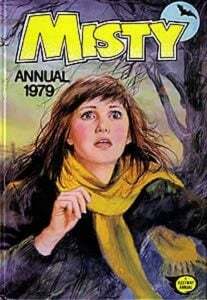
Full of tales of spontaneous combustion, disappearing crew men and lighthouse keepers, alien life forms, blood rain and silver fish falling from the skies, crop circles and sea monsters. Well-known tales as well as regional superstitions, and quirky fairy stories. Lost cities and ancient burial grounds- this book has it all and more. There’s even a glossary at the back to explain trickier words, which I found very helpful.
The book’s beautiful illustrations are accompanied by a very decent amount of information, leaving you informed but wanting to find out more.
Take a look inside The Big Book of Mysteries:
Joanna Jordan, Senior Production Controller, chose Haunted House by Jan Pienkowski and Nosy Crow’s We’re Going On A Pumpkin Hunt by Goldie Hawk and Angie Rozelaar
There’s nothing quite like the delicious thrill of a scary book at Halloween! When I was a child these were fewer and further between which made Jan Pienkowski’s Haunted House a delightfully chilling surprise. I remember being both completely terrified by and totally drawn to its surreal story (Did I really want to let myself in? What happened to the Doctor and who was in that box??). I was also obsessed with all the hidden surprises, pop ups and mechanisms to the point that they were all stuck together with Sellotape by the time I was grown. The sound of the saw on the box is still one of my favourite ever pieces of paper engineering (and I work in print production so these things appeal to me!)
These days children are much better catered to with memorable titles they want to return to again and again. One such is We’re Going On A Pumpkin Hunt (Goldie Hawk and Angie Rozelaar) which must serve its purpose because my daughter demanded ‘Again’ after I’d read it to her for the first time – always the seal of approval. Like its well known namesake, in this title you’re also drawn in by the repetitive phrasing and onomatopoeic noises (meow, flap, creak, swish), all the way to your final trick or treating pumpkin decorated destination. Plus the use of the same neon orange pantone throughout (again, a production geek!) really makes the images zing.
Whatever you choose to curl up with this Halloween I hope it’s a similarly ghoulishly good read!
Take a look inside We’re Going on a Pumpkin Hunt:
Ellie Arnfield, Sales Assistant, chose The Twisted Tree by Rachel Burge, White Smoke by Tiffany D Jackson, and Nosy Crow’s Peekaboo Pumpkin by Camilla Reid & Ingela P Arrhenius
As a superfan of the supernatural, I am always recommending spooky books to anyone who will listen! Although picking a favourite was a challenge too far, so here are two!
The Twisted Tree, by Rachel Burge, is the book that first got me into horror. Think ghost story meets YA meets Norse Mythology. It’s absolutely terrifying and I would not recommend reading it on your own in the dark!
Another spooky read I will always recommend is White Smoke by Tiffany D Jackson. Mari and her family move to the small town of Cedarville for a fresh start but are literally haunted by the ghosts of their past… While investigating the mysterious happenings in her house, Mari and her friends begin to uncover the disturbing injustice and corruption gripping their town.
My favourite Nosy Crow book of all time is conveniently also a spooky read! Peekaboo Pumpkin is the perfect mix of cute and aesthetic but with all the iconic Halloween themes. It’s the kind of book that I would have been completely obsessed with as a child.
Take a look inside Peekaboo Pumpkin:
Kirsty Stansfield, Publishing Director for Fiction, chose the Point Horror series and Nosy Crow’s The House on the Edge by Alex Cotter
Early on in my career (reeeeally early on, I had practically only just left school, ahem) I worked on the Point Horror series that Scholastic UK brought in from the US. Every single title was a complete joy – the glamour of the US settings, the freedom of the teenage protagonists with their high-tops and walk-in wardrobes and the fact that they put themselves in perilous situations over and over again, and then came back for more. Have a dreadful time babysitting in a spooky house and nearly die? Sure. Fancy babysitting again next week? Sure! Point Horror was hugely popular with its 12+ readership and sniffed at by those somewhat older who saw it as slight and formulaic, but it was perfect comfort reading after a hard day at school, just the right amount of thrills and spills and everyone home safe for tea (mostly). Marvellous.
In a slightly different vein but just as excellent is The House on the Edge by Alex Cotter. No walk-in wardrobes for Faith – her house is perched on the edge of a crumbling cliff, there are sea ghosts in the basement and she’s not sure if her new best friend is dead or alive. Don’t read it too late at night but do read it if you like brilliantly told ghost stories with heft and heart.
Take a look inside The House on the Edge:
We’d love to hear some of your own spooky recommendations, too! Let us know on socials what you’ll be reading this Halloween by tagging @nosycrow.
The post Our Favourite Spooky Reads appeared first on Nosy Crow.
October 26, 2022
It’s Thriller Time! – a spooky guest post from Dashe Roberts
We’re positively thrilled to have published Sticky Pines: The Valley of the Strange last month – the latest explosive instalment of the cult sci-fi series for children. And today we’re very excited to be sharing a guest post from Dashe!
—
‘And though you fight to stay alive, your body starts to shiver / For no mere mortal can resist the evil of the thriller…’ – Vincent Price
Shhh… Listen… Can you hear it? The rasp of dry leaves blowing across the grass? The whistle of the wind through spindly bare branches? The bubble of spiced lattes brewing in darkened cafes? The telltale signs of the Spooky Season are upon us, bringing a chill to the air, a gossamer coat of spiderwebs to our windowsills, and a creepy, kooky, decidedly ooky flavour to our reading diets. But what makes a good thriller? And, more importantly, are scary stories making a comeback in the children’s book market, where tales of talking animals and magic schools tend to keep the tone as cosy as a four seat sofa.
I think they are, and as a writer of spine-tingling books, I couldn’t be more excited.
From the rib-tickling horror of Jennifer Killick’s Crater Lake and Dreadwood to the wildly inventive monsters lurking in Aisling Fowler’s Fireborn, thrilling, scary stories are on the rise.
Frightening themes have always been present in children’s literature, designed to instruct kids about the scary realities that exist in the world, as evidenced by the evil stepmothers, shapeshifters, ogres, and child-devouring witches found in old fairytales. Folklore was a source of great inspiration for my own Sticky Pines series, as were the popular American horror books of the 1990s. Growing up as a child attending school in California, my friends and I furtively passed around our prized copies of Goosebumps by R.L. Stine or Scary Stories to Tell in the Dark by Alvin Schwartz, a collection of nightmare-inducing tales as old as time.
Gawking and gagging at the wonderfully hideous illustrations by Stephen Gammell, we delighted in spooking each other silly. Why did we do it? As kids know quite well, there is something deeply empowering about facing your fears, torch in hand and heart aflutter, from the safety of your own bedroom.
Scary stories have evolved since their nascent days, and it now takes more than simple jump scares and dark omens to tickle a horror fan’s fancy. So, what makes a good modern thriller? The best have several qualities in common: immersive atmosphere, great characters, and sophisticated pacing.
The first challenge to creating a spooky tale is crafting the perfect setting. Your world must envelop the reader, evoking a sense of foreboding from all the senses: the creak of floorboards, the scent of fresh mud, or the dusty, claustrophobia of a room that hasn’t seen daylight in decades… A fabulous example is the Lockwood & Co series by Jonathan Stroud, set in a world where ghosts are real, dangerous, and terrorising the countryside. Stroud’s Britain is altered to fit this circumstance, with ghost-repelling lamps planted on every street corner and spook-busting businesses run by teenagers, as young people are the only ones who can clearly see the apparitions. A particularly evocative sequence appears in The Screaming Staircase, when the series’ protagonist Lucy slowly realises, through the creep of shadows and chill air, that there is a particularly nasty spectre lurking in her bedroom.
The next step is to populate your world with compelling characters. These are people you grow to know inside and out, whose lives and wellbeing you become as invested in as you would a dear friend. In Aisling Fowler’s Fireborn, Twelve is a young girl trained in the art of battling fearsome monsters. But despite her toughness, Twelve is plagued by anxieties and nightmares that she must overcome in order to defeat the creatures who have thrown her world into turmoil. When I wrote Sticky Pines, I wanted to create two protagonists who viewed life through opposing lenses, but who eventually had to come together for the greater good. Lucy Sladan is a working-class girl obsessed with proving the existence of the Unknown. Milo Fisher is a wealthy boy whose father may be up to no good but who unquestioningly believes in a rational world where adults have our best interests at heart. Through several monstrous trials, the two must overcome their differences to face down an existential threat to the human race.
And lastly, a good thriller is a total page-turner. Readers should be chewing their nails as they flip through each chapter, desperate to find out what misfortune befalls the main characters next, and how on earth they might find their way out of trouble. In Alastair Chisholm’s The Consequence Girl, Cora flees her home when she is pursued by nefarious government agents determined to use her amazing, dangerous powers to their ownadvantage. Cora and her friends travel from town to town across a post-apocalyptic landscape. At every turn, their pursuers are just a few steps behind, with high-tech weapons and eerie tracking tools at their disposal. Chisholm’s skillful storytelling, thought-provoking themes, and continual raising of stakes make it impossible to put this brilliant high-concept thriller down.
This is an exciting time for stories featuring action-packed, evocative, goosebump- inducing thrills. So, asthe nights grow longer and the cool air nips at your toes, grab your torch and blanket, stock up on pumpkin pie, and reach for your favourite spooky story. And don’t forget to turn off the lights!
—
Thank you, Dashe! You can order a copy of Sticky Pines: The Valley of the Strange from Waterstones here, Bookshop.org here, or from Amazon here.
Read the first few chapters below:
The post It’s Thriller Time! – a spooky guest post from Dashe Roberts appeared first on Nosy Crow.
October 19, 2022
A guest post from Wren author, Lucy Hope
This month we’re absolutely delighted to have published Wren – a dark, gothic adventure set on the island of Anglesey in North Wales. And today we’re very excited to be sharing a guest post from Lucy!
—
I’m so excited that Wren has fluttered out of the Crow’s Nest and into the big wide world, as her story is very close to my heart. Like Wren, I grew up in North Wales in an ancient house filled with the memories of my ancestors and the stories of the people who came before me.
The story of Wren began with the setting on Anglesey, one of my favourite places in the world. If you’ve ever stood on the southern shore of the island you may have found your breath swept away at the sight of the mountains of Snowdonia watching you from across the Menai Strait. There’s something quite magical about two giant land masses, separated for thousands of years, yet still very much connected.

Wren’s house was inspired by the old house I grew up in just outside the town of Mold (Yr Wyddgrug) in North East Wales. It was ancient, with six-foot-deep walls, a very dark past and steeped in Welsh history; there was something quite unique about growing up in a place where dark shadows and memories seem to lurk in every corner. One day I’m sure I’ll set a story in a ‘normal’ house, but for now my old home has provided all the inspiration I need for creating dark, gothic mysteries like Wren!
I’ve always had a strong sense of my Welsh heritage, mostly because I grew up surrounded by portraits of my ancestors whose silent gaze watched my every move! In my adult life I’ve loved researching my family history and was very excited to find that Llewellyn the Great or Llewellyn ap Ioworth (who lived between 1173 and 1240) and became Prince of Wales, was a many-greats grandfather! He probably has hundreds of thousands of descendants, but I was excited by the discovery! Like Wren, I had an ancestor who lived in my old family house and I grew up hearing stories of his bravery. His name was Rheinallt ap Gruffudd ap Bleddyn and on dydd Calan, New Year’s Day, 1465, he attacked the men of Chester at a New Year’s fair at Mold after they began plundering his lands. Rheinallt seized Robert Bryne, a former mayor of Chester, and hanged him from a staple in the dining room ceiling that remains to this day, a reminder of the house’s brutal past.
 Wren feels an overwhelming urge to fly like a bird, at a time when very few people had managed to design anything that would stay up in the air for more than a few moments. I’ve always been fascinated by the idea of flight, and flying creeps into all my writing, even when I’m not really intending it to. I love visiting flying museums – my favourites are the Royal Air Force Museum at Hendon, Aerospace Bristol and the Brussels Air Museum – all of which contain fabulous contraptions cobbled together with string and timber that somehow lifted up into the air and flew. I love hearing stories about how early pilots seemed so fearless, their good sense clouded by their overwhelming desire to fly. I live just up the road from the ancient market town of Malmesbury in Wiltshire. One of the many things the town is known for is a monk, Eilmer of Malmesbury who attempted to fly in 1125 by leaping from the top of the abbey with a pair of home-made wings attached to his back and a heart full of hope. Amazingly, he survived, but broke both his legs which probably wasn’t much fun in the twelfth century!
Wren feels an overwhelming urge to fly like a bird, at a time when very few people had managed to design anything that would stay up in the air for more than a few moments. I’ve always been fascinated by the idea of flight, and flying creeps into all my writing, even when I’m not really intending it to. I love visiting flying museums – my favourites are the Royal Air Force Museum at Hendon, Aerospace Bristol and the Brussels Air Museum – all of which contain fabulous contraptions cobbled together with string and timber that somehow lifted up into the air and flew. I love hearing stories about how early pilots seemed so fearless, their good sense clouded by their overwhelming desire to fly. I live just up the road from the ancient market town of Malmesbury in Wiltshire. One of the many things the town is known for is a monk, Eilmer of Malmesbury who attempted to fly in 1125 by leaping from the top of the abbey with a pair of home-made wings attached to his back and a heart full of hope. Amazingly, he survived, but broke both his legs which probably wasn’t much fun in the twelfth century!
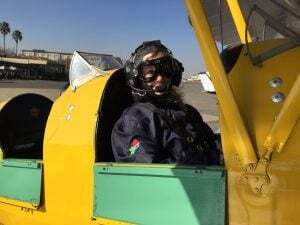
I have lots of pilots in my family. They all died long before I was born, but growing up hearing about their daring deeds helped to shape Wren’s character, who, like them, couldn’t resist the urge to fly. In 1930, one of my great uncles attempted to emulate Charles Lindberg’s solo flight across the Atlantic but his Puss Moth aeroplane exploded on take off at St Johns, Newfoundland. He survived and continued to fly until he crashed while flying over the French Alps during a thunderstorm in the middle of the Second World War. In 2016, I went flying in a Tiger Moth over South Africa. This was one of the most magical and memorable experiences of my life, and the feeling of taking into the air in a little biplane is something I’ll never forget, and I was keen to bring my experience of this flight into Wren’s story.
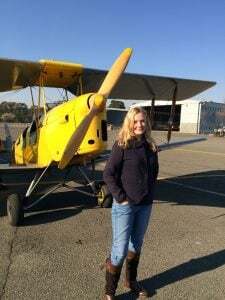
I could talk for days or even weeks about the things that inspired Wren. I see the book as being inspired by my own childhood in an ancient house in Wales, mixed in with my love of the North Wales landscape and fascination with the country’s turbulent past. I hope my readers will take what they want from the story, but the thing I admire the most about Wren is her absolute determination to fight against the conventions of the day and be the person she was born to be. I hope you love her story and are inspired to follow your own dreams, whatever they may be.
—
Thank you, Lucy! You can order your copy of Wren from Waterstones here, Bookshop.org here, or from Amazon here.
Read the first few chapters below:
The post A guest post from Wren author, Lucy Hope appeared first on Nosy Crow.
October 17, 2022
Read an exclusive extract from Murder At Snowfall – an gripping new thriller from Fleur Hitchcock
This November we’re absolutely delighted to be publishing Murder At Snowfall – a gripping thriller for readers who like danger and mystery and chills and spills from the comfort of their sofas from Fleur Hitchcock, author of Mouse Heart and Murder In Midwinter.
And today we’re very pleased to be sharing the first few chapters of the book – you can read an extract below!
When Lucas and Ruby find an abandoned trunk covered in snow, Lucas says there’s bound to be a body inside. Ruby laughs but what if he’s right? Nervously she starts to open it, and immediately wishes she hadn’t. From that moment on, they’re drawn into a thrilling mystery, one that they have to solve before the falling snow smothers all trace of wrongdoing…
Take a look inside:
Murder At Snowfall will be published on November 3rd – you can order a copy from Waterstones here, Bookshop.org here, or from Amazon here. Do let us know on socials what you thought of the first few chapters when you’ve finished reading!
If you’d like to stay up-to-date with all of our latest book news, including exclusive previews, giveaways, award news and more, you can sign up for our newsletter here.
The post Read an exclusive extract from Murder At Snowfall – an gripping new thriller from Fleur Hitchcock appeared first on Nosy Crow.
October 14, 2022
An open call for submissions from picture book creators of colour
If you’re an author or author-illustrator of colour, we want your picture book stories!
Last year’s call for submissions resulted in the signing of two new picture books. Publishing first in July 2023 will be Nabil Steals a Penguin, written by Nishani Reed and illustrated by Junissa Bianda, a hilarious story about friendship and family, welcoming newcomers, and a boisterous penguin who loves curry. This will be followed by Daddy is Cleaning, written by Angel Dike, a witty and warm celebration of the relationship between a father and baby, and the everyday tasks that descend into complete chaos when the baby ‘helps out’.
We were bowled over by the variety of submissions we received and will be running the picture book open submissions window again this year, from the 17th to 31st October 2022. We hope that this project will help us increase the diversity of our picture book creators, and publish stories with characters and themes that better reflect the multicultural society in which we live.
There are no restrictions in terms of theme, plot or characters, but texts must be suitable for children aged around 3–5 and can be in prose or rhyme (though prose is slightly preferred from the perspective of selling stories internationally).
Before submitting your stories to us, we would like to ask that you familiarise yourself with current fiction picture books for children aged around 3–5, especially if you’re new to writing for this age group.
Please send no more than three picture book texts to Submissions2022@nosycrow.com, along with a short biography in the body of the email. I’m afraid any submissions received after the 31st of October will not be considered. If you miss the deadline, please do submit the next time we run the open submissions window.
With the help of my colleagues in the picture book team, I will review all submissions, and we will respond to you by the 16th of January 2023 to let you know whether or not you have been shortlisted.
It’s free to submit stories, and we welcome submissions from around the world, but they must be in the English language and unpublished anywhere in any country. Authors and author-illustrators must be aged 18 or older.
Texts should be no more than 1,000 words each and submitted as a Microsoft Word document (or similar document that can be opened in Microsoft Word) or Adobe PDF file. They should be sent as an email attachment. Unfortunately, we are unable to accept paper submissions.
If you are an author-illustrator, texts can be accompanied by your artwork. PDFs should be no more than 5MB in total. If you’re an author-illustrator, please also include a link to your website and/or social media pages, where we can view more of your artwork.
If you’re not an author-illustrator, you don’t need to include any illustrations. Feel free to include illustration notes if needed but keep these to a minimum.
Don’t worry if you forget to attach something to your email. Please resend the entire submission with an alert at the top to let us know to delete your earlier submission.
If you have any questions, email Submissions2022@nosycrow.com. I’m looking forward to hearing from you, either via your agent, or directly from you if you don’t have one.
Good luck!
The post An open call for submissions from picture book creators of colour appeared first on Nosy Crow.
October 13, 2022
Three Ways in Which Starting a Company is like Running a Marathon
Well before signing on to help start Nosy Crow Inc, and after many years of flirting with the idea, I made the decision to run my first marathon this fall.
It is certainly cliché to say that starting a company is like running a marathon. But as I find myself in the middle of trying to do both, I really understand why. And thus, I cannot help but consider the lessons I’ve learned from both challenges.
Here are a handful of takeaways from my marathon training that can also be applied to beginning a business.
1. There are no shortcutsThe first and most obvious lesson from my marathon training program is simply: there are no shortcuts. To be successful on race day, one must put in the miles during training. Do the work, trust the process, and race day will take care of itself. The analogy to business is simple: to create great books, or deliver a compelling sales pitch, what matters most is the time, thought, and careful consideration that go into each step before the book is printed or the customer visited.

Setbacks will occur. What I’ve learned is not to ignore the doubt or the pain in the knees, but rather to take some time to dwell on the reasons behind them. I’ve even found that when out on a run and the doubt and discomfort creep in, it is helpful to give voice to those feelings. I will say out loud, “I am not sure I can finish another mile,” or “my feet hurt.” It is only then that I can fully let go, clear my head, and keep moving forward. I find this to be useful in the office as well. When things are difficult, it is imperative to talk through the underlying issues that led to the setback or rejection. Why did things go awry? How can we make sure it does not happen again? Learn from these lessons and challenges so that you may be in a better position when the inevitable challenges arise again.

Sometimes the best way to be able to run fast is to run slow. While speed can be necessary sometimes, the bulk of the work will be at a slow and steady pace over a long duration. A pace that allows you to take the time to set up solid processes, think through a complicated negotiation, teach, and learn from those around you. Like with running, sometimes you need to slow down to be able to move faster in the future, with a solid base of knowledge and the courage of your convictions well seated. I sometimes must force myself to slow down – this has been the case with Nosy Crow Inc, and in my marathon training. And I need to keep reminding myself that sometimes going slowly yields better results than going quickly.
Looking aheadAs I write this, I am cognizant of two dates: November 6, 2022, and May 2, 2023. These are the dates of the New York City Marathon and the publication of Nosy Crow Inc’s first books, respectively. While I keep these dates in the back of my mind, I try to focus more on the present, putting in the work daily, learning from mistakes, leaning into discomfort, and moving forward at a steady, even pace. And last but certainly not least, I try to have fun and to enjoy the ride!
—
If you’d like to keep up-to-date with Nosy Crow Inc news, be sure to follow us on social media at @NosyCrowUS. For any questions relating to our North American wing, please email hello@nosycrow.com.
The post Three Ways in Which Starting a Company is like Running a Marathon appeared first on Nosy Crow.
October 7, 2022
National Poetry Day!
How did you celebrate National Poetry Day?
We were delighted to showcase our love of the poetic form with an abundance of activity for And Everything Will Be Glad to See You – our recently published, inspiring collection of poetry for women and girls, selected by Ella Risbridger and gorgeously illustrated by Anna Shepeta.
A Visit to The Children’s BookshopElla Risbridger kickstarted the day by spending a lovely morning at the Children’s Bookshop in Muswell Hill, London with the wonderful pupils of Sarum Hall School, where they got stuck in to write lots of poetry together!

Ella also recently sat down with UK Mums TV for a coffee-break interview, where she discussed the key ingredients for a good children’s book, and lots more! Grab a cuppa and read the full Q&A here.
Pie Lady BooksPie Lady Books, online book reviewer, artist, and creator of the Book Pie had the Crow’s Nest in awed wonder as she revealed her creation of the cover of And Everything Will Be Glad to See You in pie form – it’s almost too good to eat!
You can read her delicious review on Instagram here.

We teamed up with Digital Marketing Agency, Tandem Collective to launch an official read-along for this wonderful anthology, with copies of And Everything Will Be Glad to See You sent to excited online influencers to share their experiences and favourite poems on on Instagram. Follow the hashtag here to catch up with the reviews!
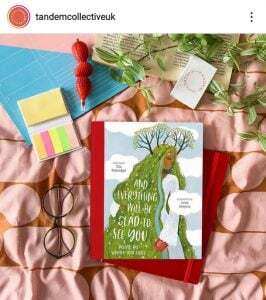
We’re so grateful for all of the amazing reviews we’ve received for And Everything Will Be Glad to See You – so much so that we couldn’t resist compiling the highlights into an animated trailer, which you can watch below through our Nosy Crow YouTube Channel, along with more of our Poetry Collections.
Take a look inside the book:What’s your favourite poem? Let us know on social media, by tagging @NosyCrow to be featured on our channels. Happy Reading!
You can order a copy of And Everything Will Be Glad to See You from a host of retailers, including Waterstones, Bookshop.org, or from Amazon.
The post National Poetry Day! appeared first on Nosy Crow.
September 30, 2022
What it was like to Abridge The Wind in the Willows – an Experience, by Lou Peacock
In celebration of Autumn, Lou Peacock, our wonderful Publishing Director of Picture Books, shares her experience of working on the abridged edition of The Wind in the Willows.
—
I still can’t quite believe that I have had the wonderful good fortune to work on an abridgement of The Wind in the Willows. I keep pinching myself, and now I’m black and blue! I wear many hats in my writing and editorial life – I’m mainly a publisher and editor but I’m also a picture book author and poetry anthologist – but never thought I would add an abridgement hat to the collection, too. It might just be my most exciting hat yet.
I say “exciting”, but it was also EXTREMELY daunting. This was my first time abridging a book – how could I do the original justice? And not tread on Kenneth Grahame’s toes? Can you imagine?! To be frank, I was a little overwhelmed. So, like any self-respecting author, I sharpened my pencils, tidied the desk, took the dog out, bought some biscuits and did the laundry. Then, after a stern talk with myself, I made a start.
The Early Stages of Abridging a ClassicI started by looking back. What was it about the story that really appealed to me as a child? A series of very distinct images came to mind – Ratty and Mole in the boat, the snow in the Wild Woods, the train chasing after Toad – but these dramatic moments were all mixed up with an intense love of the world of the book and the connection between the characters. I LOVED the idea of animals living in a parallel world to our own and was fascinated by the domestic detail of how they lived, the warmth and cosiness of their homes, what they ate, how they dressed.
Now, coming to it as an adult and a writer, I can see that Grahame’s magic worked on many levels and this is his true genius. He created a world that children would want to disappear into, characters whom they would want to befriend and adventures that were impossible to resist. No wonder it is a story that has stood the test of time. I wanted our abridged version to evoke the same kind of feelings, so I rolled up my sleeves and got to work.
The first thing to consider was the sheer volume and length. The original story is about 60,000 words long, but our picture book version only had space for 10,000 words – quite a difference! Some moments would have to go, but which ones? I knew I would have to harden my heart and edit the parts that are less well known and might be less appealing to a contemporary reader, whilst keeping as much of the original as I possibly could.
And then, whilst I was thinking about content, I also had to think about the language. Grahame has a very distinct and particular voice and I wanted to make sure that it sang on every page. There are famous lines that I knew readers would want to find, such as “messing about in boats”, and I made these favourite phrases anchor points for particular scenes. Where I made a change or cut, I made sure that the loss wasn’t noticeable in any way. My aim was for things to be seamless, to keep the flow and charming voice throughout . . . and hope that Grahame would approve!
Of course, if we’re thinking about language, then we also have to think about the typical reading age of a picture book audience. The original story appeals to most ages but the language is quite sophisticated, and I wanted our fully illustrated version to appeal to emerging readers. I thought long and hard about the register of the language and what might be an accessible choice of vocabulary. It’s always good to have a few words that might push a reader, but not so many that they become a barrier to enjoyment and comprehension.
“Grahame has a very distinct voice and I wanted to make sure that it sang on every page… My aim was for things to be seamless, to keep the flow and charming voice throughout… and hope that Grahame would approve!”
Working with Kate HindleyBut I couldn’t think about any of these points without also thinking about the illustrations. In a picture book, images and words combine perfectly to tell a story, but The Wind in the Willows is a dense, word-heavy novel – how would we bring the story to life visually? As I studied the book closely, I began to identify the key moments in each chapter – the first sighting of the alluring motor car, the intricacies of Badger’s underground home, the dramatic climax in Toad Hall – and used these cornerstone moments to structure things visually.
Also, I wanted to make sure that Kate Hindley had as many opportunities as possible to work her magic . . . in a picture book, the words are only half the story, and the pictures themselves say so much.
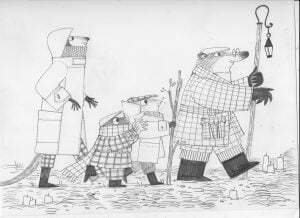
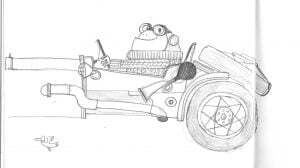
Like Grahame, Kate Hindley is a genius. We have worked on several picture books together, and when we discovered that she was a huge Willows fan, we just knew she was the artist for the job. When I had finished working on the story, Nia Roberts, our Creative Director, carefully set the text in layouts to create plenty of space for Kate’s art. This is the incredible, invisible work that designers do behind the scenes – deciding between full spreads of art versus single pages, or pondering whether a small, simple vignette might be best for a particular moment. Then, when Nia had a rough shape she was happy with, we worked on it together. We perfected page turns for dramatic moments, shifted bits around and so set the pacing for the story visually.
And then it was over to Kate. From the first character sketches to roughs to the finished art, it felt like Christmas every time something new arrived. Picture books don’t just rely on characters but on worlds, and how the characters inhabit those spaces. Kate is extremely skilled when it comes to creating engaging, appealing characters, and her scenes are layered with the most beautiful patterns and quirky details that will keep children absorbed for hours. Even now, I couldn’t tell you what I love more – the intricately detailed Edwardian world or the adorable charm of Mole in his pinstripe suit. I can’t think of a favourite scene because they are ALL brilliant. I do have a particular fondness for the moment where Mole falls in the water after his unsuccessful attempt at rowing . . . the way the objects drift down, Mole’s expression, the ineffable sadness of the lost cake.
But then there’s the cosiness of Badger’s kitchen and the winter store room where Mole and Ratty sleep. And what about the first glimpse of Toad Hall in all its Arts and Crafts splendour? So many wonderful images . . .
What I Enjoyed Most About this Experience

It’s been such a privilege to work on this beautiful book and I hope people will enjoy reading it as much as we have loved creating it. I hope readers will find favourite moments and I hope those moments will stay with them. I’ve discovered a new favourite and it’s a real keeper. It’s the moment when Ratty and Mole find Badger’s home after being lost in the snow. Badger opens the door and greets them both with a little pat on the head each, saying, “This is not the sort of night for small animals to be out.” There is a huge amount of affection in these simple words. Badger might seem a little gruff, but he is full of love for his friends and, for me, that is the key to The Wind in the Willows – it’s packed with adventure but it’s also all about love and friendship. So perhaps my favourite image has to the last one of all, where our four heroes wander through the woods, fixed forever in time as a band of friends who would do anything for each other.

You can order a copy of The Wind in the Willows from Waterstones here, Bookshop.org here, or from Amazon here.
Can’t wait for the home delivery? Indulge in the first few chapters below:
The post What it was like to Abridge The Wind in the Willows – an Experience, by Lou Peacock appeared first on Nosy Crow.
September 29, 2022
John Mendelson visits the New England Independent Booksellers 2022 Fall Conference
As I drove from my home in Massachusetts down to Providence, Rhode Island, to attend the New England Independent Booksellers fall conference – to be held in person for the first time since 2019, and just a week after publicly launching Nosy Crow Inc here in North America – I was flooded with memories of prior trips to NEIBA, as we in the industry call the show. In fact, I was struck by the realization that I attended the show for the first time 25 years prior in 1997. Despite being something of an old hand in the New England bookselling community, attending for the first time with Nosy Crow, I was also somewhat surprised to be brimming with nerves and anticipation. When I pulled into the parking lot of the exhibition hall, I had a moment of panic that I’d driven to the wrong location as I’d been on autopilot and just assumed the show was to be held where it always had been! A quick check of the program confirmed that my instincts, if not my preparation, were sound. Phew.
Setting up the Nosy Crow Inc displayI quickly got to work setting up our small table next to our distributor, Hachette Book Group’s larger display, and unfurled our newly printed bright red table cover with the Nosy Crow logo on the front. Once set up, there was time for one more coffee and a quick walk around the show floor before the doors opened and booksellers started their pilgrimage from table to table, eager to see the new books, grab a handful of sought-after galleys, and chat about business.
Familiar facesMany familiar faces came by to say hello and to see some of our 2023 books in printed form. It was thrilling to hear from so many people who’d read the articles about our launch in places like Publisher’s Weekly, Shelf Awareness, Publishing Perspectives and more, and wanted to learn a bit more about our plans. I was also fortunate to spend some time with our Hachette sales representative for New England, with whom I worked at Houghton Mifflin Harcourt in the early 2000’s, and to get to know Karen Torres who is overseeing Hachette’s business into the independent bookstore market nationwide. The Hachette team is fantastic and I can’t wait to get to know more of their reps in the coming weeks and months as we work together to bring our first books to market in May of 2023.
A sea of new booksOne thing that always strikes me when attending book conferences, and this one was no different, is just how many books are published in a given year. While I know this to be the case from looking at Bookscan, reading industry reports, etc., there is nothing that quite brings it home as walking a large conference floor and seeing the sea of new books out there. While intimidating, this is an experience to keep present as, to me, it is an important reminder both of the relentless competition in the book market, and also, more importantly, just how critical it is to bring the care and attention to each and every book we publish at every step of the way from acquisition to editing, designing, producing, marketing, and selling.
Writing from the skySpeaking of selling, I am writing this blog from 36,000 feet, having just crossed the Mississippi River, on my way to see a customer on the other side of the country and to show them some of the books we have in store for 2023 and beyond, and the nerves and excitement remain. I’ll be sure to let you know how it went next week.
—
If you’d like to keep up-to-date with Nosy Crow Inc news, be sure to follow us on social media at @NosyCrowUS. For any questions relating to our North American wing, please email hello@nosycrow.com.
The post John Mendelson visits the New England Independent Booksellers 2022 Fall Conference appeared first on Nosy Crow.
Nosy Crow's Blog
- Nosy Crow's profile
- 35 followers



